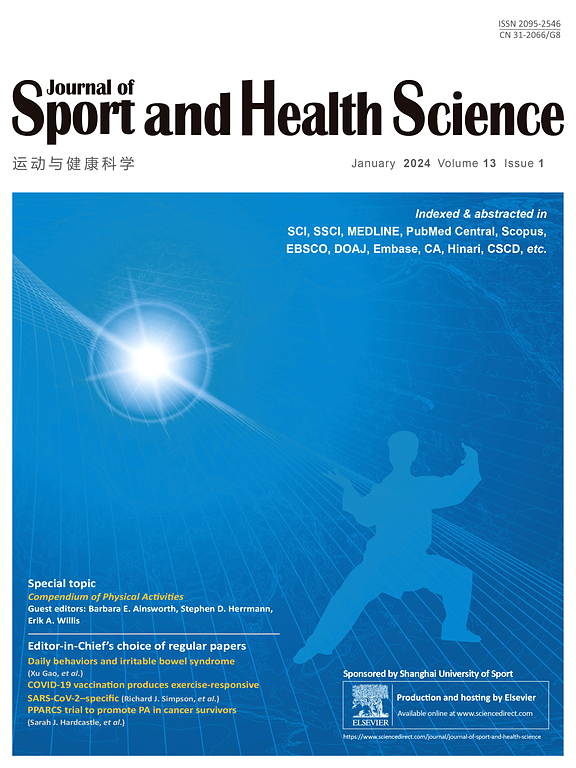Association of physical activity, cardiorespiratory fitness, grip strength, and grip strength asymmetry with incident musculoskeletal disorders in 406,080 White adults.
IF 10.3
1区 医学
Q1 HOSPITALITY, LEISURE, SPORT & TOURISM
引用次数: 0
Abstract
BACKGROUND Musculoskeletal disorders (MSDs) represent a significant global health burden. While physical activity (PA) and physical fitness are both thought to reduce MSD risk, their independent and joint associations with MSD incidence have not been fully explored. This study investigated the independent and combined effects of PA, cardiorespiratory fitness (CRF), grip strength (GS), and GS asymmetry on MSD incidence in a large prospective cohort. METHODS We analyzed data from the UK Biobank cohort (2006-2023), including 406,080 participants aged 37-73 years (age = 55.7 ± 8.2 years, mean ± SD; 53.0% female) who were free of MSD at baseline and during the first 2 years of follow-up. PA, derived from self-reported data and expressed in total metabolic equivalent hours per week (MET-h/week); CRF (watts (W)/kilogram (kg)), measured using a cycling exercise test; and GS (kg), measured by hydraulic hand dynamometer, were included as exposures. GS asymmetry was defined by the left-to-right hand strength ratio. MSD incidence was determined via hospital records. Time-to-event associations were analyzed using Cox proportional hazards regression models with restricted cubic splines to account for non-linear relationships. The analysis was conducted in April 2024. RESULTS Over a median follow-up of 14.7 years, a total of 73,002 incident cases of MSDs were recorded (rheumatoid arthritis: 2923; osteoarthritis: 54,955; degenerative spinal diseases: 15,124). Lower self-reported PA (<4.8 MET-h/week) was associated with increased MSD risk (hazard ratio (HR) = 1.07, 95% confidence interval (95%CI): 1.07-1.08). Low CRF (<1.7 W/kg; HR = 1.09, 95%CI: 1.06-1.13), low GS (<30.0 kg mean GS; HR = 1.11, 95%CI: 1.10-1.13), and GS asymmetry (HR = 1.11, 95%CI: 1.08-1.13) were also significantly associated with increased MSD risk. Good CRF and GS, and lower GS asymmetry mitigated the higher MSD risk associated with low PA levels. CONCLUSION Low levels of PA, CRF, GS, and GS asymmetry were associated with a higher risk of incident MSD. Meanwhile, improvements in CRF, GS, and GS balance could help offset the risk of MSD incidence in populations with insufficient PA.406080名白人成人的体力活动、心肺健康、握力和握力不对称与肌肉骨骼疾病的关系
背景:肌肉骨骼疾病(MSDs)是一个重大的全球健康负担。虽然身体活动(PA)和身体健康都被认为可以降低MSD风险,但它们与MSD发病率的独立和联合关系尚未得到充分探讨。本研究在一个大型前瞻性队列中研究了PA、心肺适能(CRF)、握力(GS)和GS不对称对MSD发病率的独立和联合影响。方法:我们分析来自UK Biobank队列(2006-2023)的数据,包括406,080名37-73岁的参与者(年龄 = 55.7±8.2岁,mean±SD;53.0%女性),在基线和前2年随访期间无MSD。PA,来源于自我报告的数据,以每周总代谢当量小时数(MET-h/week)表示;CRF(瓦(W)/千克(kg)),使用自行车运动测试测量;以液压手测力仪测得的GS (kg)作为暴露量。GS不对称性定义为左手与右手的力量比。通过医院记录确定MSD发病率。使用Cox比例风险回归模型(限制三次样条)分析时间与事件的关联,以解释非线性关系。这项分析是在2024年4月进行的。结果在14.7年的中位随访中,共记录了73002例MSDs事件(类风湿关节炎:2923例;骨关节炎:54955;退行性脊柱疾病:15,124)。较低的自我报告PA (<4.8 MET-h/week)与MSD风险增加相关(风险比(HR) = 1.07,95%可信区间(95% ci): 1.07-1.08)。CRF低(<1.7 W/kg;HR = 1.09,95%CI: 1.06-1.13),低GS(平均GS <30.0 kg;HR = 1.11,95%CI: 1.10-1.13)和GS不对称(HR = 1.11,95%CI: 1.08-1.13)也与MSD风险增加显著相关。良好的CRF和GS以及较低的GS不对称性减轻了与低PA水平相关的较高MSD风险。结论低水平的PA、CRF、GS和GS不对称与MSD发生的高风险相关。同时,CRF、GS和GS平衡的改善有助于抵消PA不足人群中MSD发生的风险。
本文章由计算机程序翻译,如有差异,请以英文原文为准。
求助全文
约1分钟内获得全文
求助全文
来源期刊

Journal of Sport and Health Science
SPORT SCIENCES-
CiteScore
18.30
自引率
1.70%
发文量
101
审稿时长
22 weeks
期刊介绍:
The Journal of Sport and Health Science (JSHS) is an international, multidisciplinary journal that aims to advance the fields of sport, exercise, physical activity, and health sciences. Published by Elsevier B.V. on behalf of Shanghai University of Sport, JSHS is dedicated to promoting original and impactful research, as well as topical reviews, editorials, opinions, and commentary papers.
With a focus on physical and mental health, injury and disease prevention, traditional Chinese exercise, and human performance, JSHS offers a platform for scholars and researchers to share their findings and contribute to the advancement of these fields. Our journal is peer-reviewed, ensuring that all published works meet the highest academic standards.
Supported by a carefully selected international editorial board, JSHS upholds impeccable integrity and provides an efficient publication platform. We invite submissions from scholars and researchers worldwide, and we are committed to disseminating insightful and influential research in the field of sport and health science.
 求助内容:
求助内容: 应助结果提醒方式:
应助结果提醒方式:


